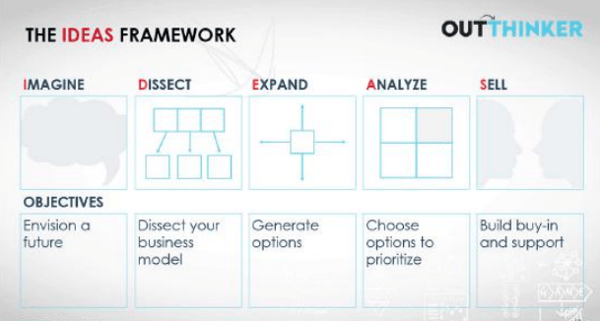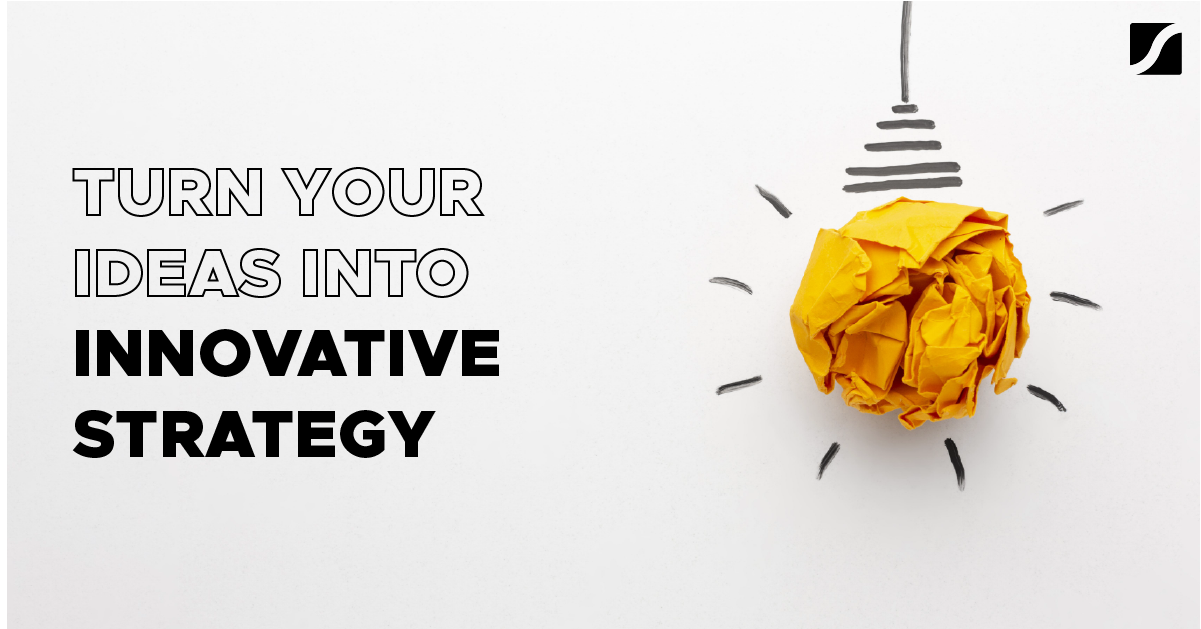Why Your Strategy Needs an Innovative Fourth Option, And How To Find It

As we head into 2021, we’re facing a pivotal moment. Our world is changing rapidly. To succeed in this challenging new business environment will require us as leaders to churn out bold, innovative strategy.
From this period of change, there's going to be two types of companies that emerge: the thinkers, and the Outthinkers.
I define outthinkers as those who “out-think” rather than outspend their competition. Outthinkers are the leaders who will embrace new concepts to drive their organization on a path toward astounding, sustainable growth.
The key to becoming the Outthinker lies in your ability to uncover, execute on, and exploit the strategic Fourth Option in your organization. Here's how you do it.
Part 1: Why The Fourth Option Matters
Part 2: Strategic Examples of Fourth Options In Companies
Part 3: How To Uncover And Exploit Your Fourth Option
Part 4: How To Get The Team Onboard
Why Outthinking With the Fourth Option is Key
Successful innovators outthink their competition. They do so by introducing startling, game-changing ideas that leave competitors in their dust.
Gandhi captured the concept this way: “First they ignore you, then they laugh at you, then they fight you. And then you win.”
In other words, you want to enact a strategy that competitors ignore or laugh at instead of copying or fighting. While they’re ignoring and laughing, you’re growing your idea. By the time they realize your concept is working, it’s too late. You’ve already won.
There are three classic ways of doing this:
- Disruptive Innovation means targeting a customer segment that competitors view as low-value or a product viewed as non-sophisticated.
- Blue Ocean strategy involves finding a new market or new customers instead of attacking an existing market or customer base.
- Take It Whole is Sun Tzu’s term from The Art of War meaning you conquer the prize in question with no bloodshed or destruction.
These are great strategies, but I call the concept we’re striving for the Fourth Option ― my metaphor for the point at which others stop thinking. It hinges on the number three, the number at which most people stop looking for additional options.
As entrepreneurs and innovators, we aren’t satisfied with three. We look for the Fourth Option that nobody has thought of but can revolutionize your business.
Competing Against a Fourth Option
What’s it like to compete against someone who introduces a Fourth Option?
Track and field athletes from the 1968 Summer Olympics know. Before that year, athletes went over the high bar using one of three methods: scissors, straddle, or roll.
Then, American athlete Dick Fosbury introduced a Fourth Option: He went over the bar backward. Imagine how shocking that was!
There was no new technology or additional equipment that suddenly made that option possible. Pads were already positioned to cushion the landing. So why didn’t someone think of it before? Two reasons:
- Unnamed concept.
Until a concept is named — such as the Fosbury Flop — you can’t find a book about it or a coach to teach it. That’s why it’s critical to identify and understand the concepts emerging around new technologies and ideas. - Disbelief.
Such concepts lead us to Fourth Options because they create disbelief in others. Before Fosbury, every gold medal winner had gone over the high bar forward. Coaches and athletes were in agreement that the way to go over was forward. To discover a Fourth Option, there’s a mental barrier that you must get over.
The power of a Fourth Option lies in the element of surprise. People expect you to do one thing, and you do something different.
The Pandemic Effect
When is the best time to introduce a Fourth Option? Historically, they become particularly valuable when the rules change. That means right now ― amid economic turmoil and a global pandemic ― is prime time to discover Fourth Options.
There is a precedent we can learn from. The world experienced similar conditions during the 1918 Spanish flu pandemic: economic turmoil, masks, sequestering, and socially distancing. People holed up inside their homes, hoping for a cure.
What followed was the Roaring Twenties, one of the most prosperous economic eras in history. Today, we could be setting ourselves up for the same thing if we learn to leverage emerging concepts.
The trends shaping industries before the 1918 pandemic accelerated during the 1920s: Conveyor belts, assembly lines, credit, chemical fertilizers, electricity, mail order, air travel, suburbs, cars, road construction, radio, chain stores, and professional advertising.
The Spanish flu accelerated the emerging concepts that were already happening.
Today’s Emerging Concepts
In 2020, we know the trends: Blockchain, new customer preferences, digital transformation, demand for personalization, regulatory uncertainty, artificial intelligence, big data, data analytics, cybersecurity, the Internet of things, and a distrust of established brands.
It’s not about understanding trends such as Blockchain or data analytics ― it’s about understanding the concepts around them. COVID-19 is accelerating these concepts, making the future closer than it’s ever been before.
The more you know about strategic concepts, the more patterns you’ll recognize, and the more likely you are to find a Fourth Option for your business.
5 Strategic Patterns To Help You Design Your Fourth Option
I study strategic concepts ― how they emerge, and how they can change the way we think. I’ve identified 36 fundamental strategic patterns from studying successful companies and trying to determine what new Fosbury Flops may be emerging.
Of these 36, there are five strategic patterns you can implement in your business now to help you find a Fourth Option to grow and scale:
1. Pattern 22: Move Early to the Next Battleground
This pattern tells us: Don’t play for today; instead, play for tomorrow. Don’t skate to where the puck is; skate to where the puck is going to be.
As the pace of change accelerates, you have less time to scale up and plateau before coming up with your next strategy. You have to be playing toward the next game even while you’re playing the current game.
Technology is changing exponentially, which creates opportunities but requires us to start planning on a further horizon. Before, only companies with significant R&D budgets could be patient and plan for possibilities in the distant future. But now, all of us must prepare for the distant future because it’s coming sooner.
Look at Pill Packs. The inventor, a second-generation pharmacist, saw that older people with multiple prescriptions often struggled. They couldn’t figure out which pill to take when, couldn’t open the bottles, and had to visit the pharmacy multiple times. He imagined a future where customers don’t leave their houses. The pills come to them, premixed in appropriate dosages with a date and time specified on easy-to-open plastic packs.
Customers open the packs at the designated times, take the pills, and they’re done.
He did the work to gain FDA approval and offer this service in 48 states. Six years later, he sold it to Amazon for $1 billion. A billion dollars in value creation achieved through Fourth Option thinking.
Thought-Starters for Moving Early to the Next Battleground
How can you discover a Fourth Option idea for your business? Gather your team together to brainstorm. Use the following thought-starters to generate ideas. Ask them:
- Where is the next battleground?
- What can we do to move there early now?
- Does it involve customer needs?
- Customer behaviors?
- Technologies?
- Regulations?
2. Pattern 34: Coordinate the Uncoordinated
The next emerging pattern, coordinate the uncoordinated, reveals a paradigm shift underway. In the old way, power came from control or ownership. Now we’re shifting to a paradigm where power comes from coordination.
We see this in the natural world when animals coordinate in schools, flocks, and herds to achieve power and safety. Many business models we admire today, such as Airbnb or Uber, don’t own what they offer. Instead, they coordinate.
Uber-type businesses are appearing in many sectors: Nursio coordinates nurses; Dectar coordinates tutors. I believe Blockchain is the next iteration because, in addition to coordinating the ledgers of digital assets, the nodes coordinating each ledger are themselves being coordinated.
How can your team go about coordinating the uncoordinated?
Thought-Starters for Coordinating the Uncoordinated
Ask your team:
- Looking at the system in which we compete, who or what is uncoordinated that we would like to coordinate?
- How or what might we coordinate around:
- Customers?
- Vendors?
- Stakeholders?
3. Pattern 7: Force a Two-Front Battle
The next emerging pattern is to force a two-front battle. This approach centers on how a company defines itself. Instead of defining themselves by industry, many of today’s successful companies define themselves in ways that offer strategic flexibility. This enables them to view themselves differently and make unexpected choices. That differentiates them ―making it impossible for competitors to keep up.
One example is Starbucks. Howard Behar, former president, explained: “We realized we were not in the coffee business serving people, but rather, we were in the people business serving coffee.” That viewpoint means that when they treat their people well, the business does well. That filter influences choices—such as providing healthcare and stock options to employees. In the coffee business, those are costs. In the people business, they’re a value-add.
Another example is Flatiron Health, a company with the mission of improving lives by learning from the experience of every cancer patient. It was formed by two ex-Google employees who found the health care system, especially within oncology, broken and siloed. There was data about each patient, but you couldn’t find overarching patterns since it wasn’t combined.
To solve this, they created a company that looks like a practice management software company. They licensed their software to oncologists at a low rate. In exchange, they asked for access to patient data (following all protocols to protect patient confidentiality).
Their goal? Identify patterns in patient outcomes. And they shared their findings with all of the oncology practices that signed up. After seven years, they sold the company to Roche for $2 billion.
In essence, they said, “We’re not a practice management company, we’re a data company that happens to be in the practice management business.”
Be aware of what business you and your people say you’re in. Your definition could redefine your entire strategy.
Thought-Starters for Forcing a Two-Front Battle
Ask your team:
- How can our company redefine what it does?
- What business are we really in?
- How would that kind of company behave differently?
4. Pattern 33: Be Good
The concept of business as a force for good isn’t new, but the pace is accelerating exponentially.
Corporations once existed to maximize shareholder value. Now, corporations realize that focusing solely on financial returns creates resistance to growth, which diminishes shareholder value over the long run. While it was once considered good to do good, there’s no longer a choice. Businesses must do good to survive.
The best strategy to create shareholder value is to create a business that’s good for the world. When a company’s growth is good for the country, environment, and community in addition to clients and employees, everybody wants you to win.
Mastercard is an excellent example. The CEO, Ajay Banga, aligned the company behind the idea that they are a force for good in the world. They are a profit-seeking, value-creating, capitalist company, but their strategy is to strive for a world beyond cash.
And yes, as they convert cash into the digital realm, they’ll make a profit. But their goal of creating a world beyond cash makes the world better through transparency and accountability. In that world, no drug dealer could sell drugs to your child without traceability. The company’s vision attracts top employees. Innovators and regulators want to work with them. Their stock is way up. At the heart of all this is the idea that their growth is good for the world.
Mastercard didn’t change its business model; they just more fully and authentically communicated their goals and vision. That’s the kind of business that will thrive, especially as we emerge from the pandemic.
Thought-Starters for Being Good
Ask your team:
- How can we do good in the world, profitably?
- What can we stop doing that’s bad?
- What can we start doing that’s good?
- How can we better communicate how our growth is good for the world?
- What’s a problem we can solve profitably?
- How can our solutions benefit all stakeholders?
5. Pattern 32: Create Something Out of Nothing
The pattern of creating something out of nothing reminds us that as you play the game of business, you’re following some rule that doesn’t exist. What is that rule, and how can you break it?
In chess, you must play the pieces on the board. But in the game of Go, you can’t move any pieces ― you can only add or remove pieces. If you played the game of business that way, what could you add or remove?
Try adding a new customer. Tony Fernandez did. He bought a failing airline for $0.27 and grew it into Air Asia ― the world’s second-largest airline. His core idea was not to compete for existing airline customers but for railroad customers who didn’t yet fly. He adjusted his whole strategy, locating planes near railroads instead of city centers, and flying out of small regional hubs to attract new customers.
How can you convert people who are not yet using your product? Identify pockets of non-consumers, and ask why they aren’t using your product or service. Typically, it’s one or a combination of four factors:
- Price
- Access
- Know-how
- Time
Price might not be the barrier. Maybe they don’t live near an airport and can’t access the service. Or they don’t know how to buy an airline ticket online. Perhaps they simply don’t have time to fly.
The question is: How can you re-engineer your strategy to remove those barriers and unlock non-consumption?
Try adding a new category, as Gatorade did. Their products have been on the sidelines of sporting events for years. Competitors didn’t see the growth because there wasn’t a line item for sports drinks on their spreadsheets — which proves that categories are strategic tools we undervalue. By the time big beverage companies recognized the category of sports drinks, it was too late: Gatorade owned it. Red Bull did the same thing with energy drinks.
Thought-Starters for Creating Something Out of Nothing
Ask your team:
- If we could magically add something to the game, what would it be?
- New stakeholders?
- New customers?
- A new occasion?
- Could we create a new category?
- Could we create a new need?
The IDEAS Framework Guides Your Thinking
Examining the five emerging strategies to identify your Fourth Option is part of an overall process to give your company a significant advantage. Let’s unpack that framework and see where Fourth Option ideas fit into it.
Unlock the strategic advantage your company needs to drive astounding, sustainable growth by using my IDEAS Framework: Imagine, Dissect, Expand, Analyze, and Sell. The five strategic patterns I introduced fall under “Expand” in the IDEAS Framework.
Here’s what you can do before and after identifying your Fourth Option to differentiate your growth strategy:
- Imagine. Envision what the future will look like, identify long-term trends, and work backward to set goals.
- Dissect. Dissect your business model, break down problems, and analyze your key leverage points.
- Expand. Generate innovative Fourth Option strategies based on the five emerging concepts.
- Analyze. Select, categorize, and prioritize the best strategies to pinpoint Fourth Option ideas that you and competitors would normally laugh off.
- Sell. Build support, establish alignment, and get buy-in from your team. Sell the idea internally.

Nix Naysayers To Innovative Ideas
As you and your team go through the IDEAS Framework, naysayers will try to stop you from pursuing a game-changing Fourth Option with comments like:
“We don’t have time to think about the future.”
“This is obviously just a marketing problem.”
“Oh, we tried that before. It won’t work.”
“I love these big ideas, but we know what works. Let’s get more efficient or invest in marketing and sales.
Tell naysayers that you will continue to focus on what’s working in the short-term while also introducing emerging strategies for a Fourth Option.
Examine Limiting Beliefs
How can you outthink rather than be out-thought? How can you disrupt rather than be disrupted? Sometimes the winning move seems like a crazy idea at first.
One of the most important questions to ask is: What are your limiting beliefs that prevent you from seeing what’s possible? In other words, what are you assuming to be true that’s preventing your breakthrough to a Fourth Option?
Finally, and maybe most importantly, listen to your team. Create a culture where your people feel free to share their wild, wacky Fourth Option ideas. One of those ideas may just be the seed that you grow into disruptive success beyond your competitors’ imagination.




